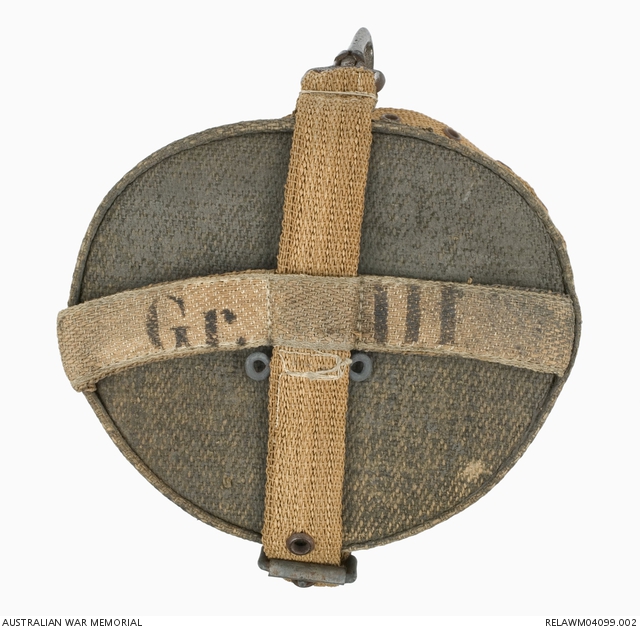| Place | Europe: Western Front |
|---|---|
| Accession Number | RELAWM04099.002 |
| Collection type | Heraldry |
| Object type | Personal Equipment |
| Physical description | Cotton, Leather, Paint, Paper, Tar paper, White metal |
| Maker |
Unknown |
| Place made | Germany |
| Date made | c 1917-1918 |
| Conflict |
First World War, 1914-1918 |
German horse respirator (gas mask) case



Cylindrical respirator case with lid, to carry a horse's gas mask. The case and lid are made from multiple layers of open weave recycled cotton/paper 'hessian' appearance fabric glued together. The outside has a field grey paint finish, while the inside has a black tarred waterproofed finish. The case is secured by a series of brown cotton ersatz 'webbing' straps, each 25 mm wide. One strap runs across the base, up each side and across the lid, joining on one side with a white metal buckle. The loose end of the strap is reinforced with leather. A white metal stop prevents the loose end from sliding back through the cross strap on the lid. A loop on the opposite side of the case holds a spring clip which attached the case either to 'D' on the front of the saddle or to the horse's breast harness if worn. The strap that secures the lid is held to the body of the case by three horizontal webbing bands. The upper and lower bands are sewn to the vertical strap; the central band slides freely on the strap and has a buckled end to adjust a further attachment point to the saddle or harness. The strap securing the lid slides through a corresponding webbing strap running at right angles to it across the lid. This strap is stamped in black 'Gr. III'. The base of the case is stamped in white 'E Gr. III'.
The history of this gas mask case is unknown. it was one of 23 collected by the Australian War Records Section from abandoned German supplies, in May 1919. The case also demonstrates the use of ersatz (substitute) materials by the Germans, developed when the Allied naval blockade, imposed after the Battle of Jutland in May 1916, prevented the import of raw materials. Material made from a combination of paper and cotton or wool rags was successfully used in place of traditional fabrics and leather, in both civilian and military applications.